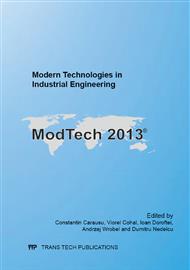p.711
p.718
p.727
p.733
p.739
p.745
p.751
p.757
p.763
Analysis of Rails of a Ferry Boat under Wheels Contact Loading
Abstract:
The paper presents the effect of the discontinuity of the rails of a ferry boat and the presence of lower modulus insulation material at the gap to the variations of stresses in the insulated rail. The analysis consists of a three-dimensional wheel rail contact model based on the finite element method. One of the results shows that the maximum stress occurs in the subsurface of the railhead of the ferry boat. The ratio of the elastic modulus of the railhead and insulation material is found to alter the levels of stress concentration. Numerical result indicates that a higher elastic modulus insulating material can reduce the stress concentration in the railhead but will generate higher stresses in the insulation material, leading to earlier failure of the insulation material. A general subsurface crack propagation analysis methodology is used for the wheel and rail rolling contact. The fatigue damage in the wheel is calculated using a previously developed mixed-mode fatigue crack propagation model. The advantages of the proposed methodology are that it can accurately represent the contact stress of complex mechanical components and can consider the effect of loading non-proportionality. The effects of wheel diameter, vertical loading amplitude, initial crack size, location and orientation on stress intensity factor range are investigated using the proposed model. The prediction results of the proposed methodology are compared with in field observations. The contact elements were used to stimulate the interaction between a wheel and a railhead. Variations in contact stress fields at various locations of the rail are sensitive to the contact distance. The location of the maximum von Mises stress was shifted to the contact surface as the contact point moves close to the rail end. A higher stress, larger deflection and significant plastic deformation occurring at the rail from ferry boat may lead to deterioration at the rail end.
Info:
Periodical:
Pages:
739-744
Citation:
Online since:
November 2013
Authors:
Price:
Сopyright:
© 2014 Trans Tech Publications Ltd. All Rights Reserved
Share:
Citation:


